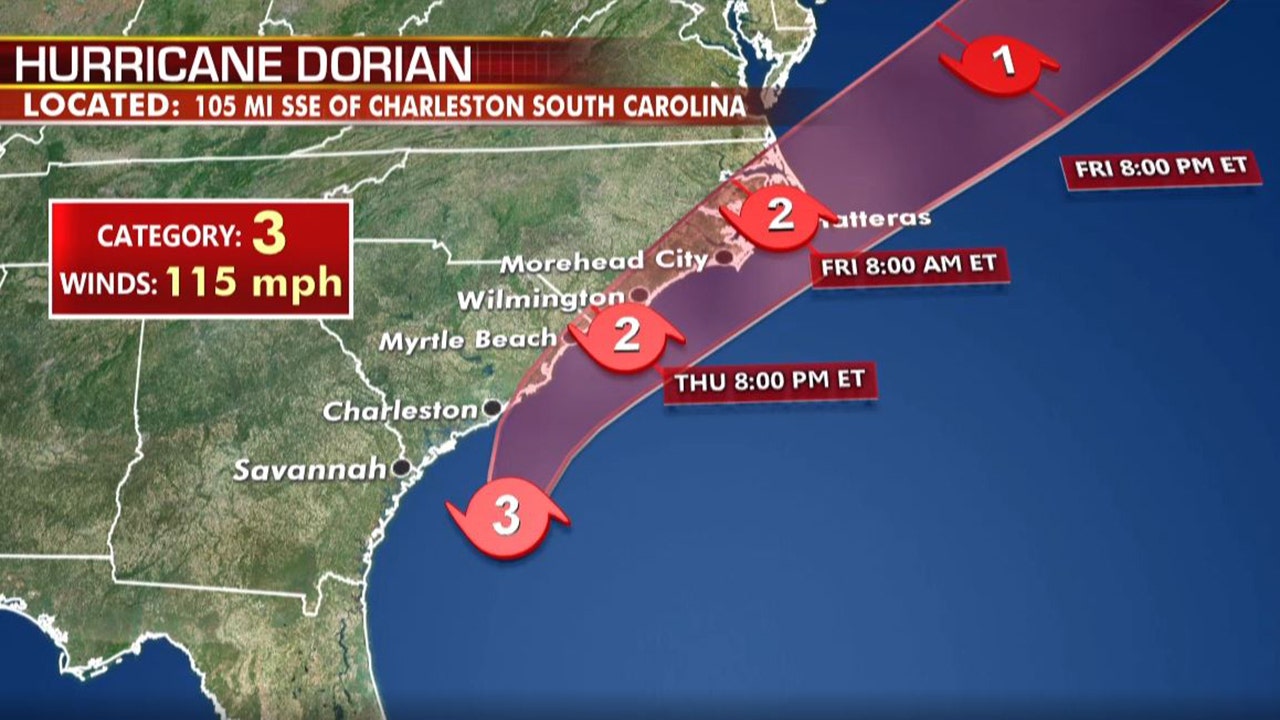 Hurricane Dorian early Wednesday morning. (NOAA)
Hurricane Dorian early Wednesday morning. (NOAA) Andrew Freedman Editor focusing on extreme weather, climate change, science and the environment.
September 4 at 8:09 AM Hurricane Dorian gradually leaves Florida behind Wednesday, setting its sights on the coasts of Georgia and then the Carolinas. These areas face a triple threat of “destructive winds, flooding rains, and life-threatening storm surges,” according to the National Hurricane Center.
While Dorian has stayed far enough off the coast to largely spare Florida from the worst of its wrath, it is forecast to make a much closer approach to the coastline of the Carolinas between late Wednesday and Thursday and could even make landfall. Impacts are thus expected to be more severe.
Around Charleston, S.C., for example, wind gusts could hit 80 mph, and water levels could rank among the top five levels ever recorded due to combination of ocean surge and 6 to 10 inches of rain. Higher wind gusts could lash North Carolina’s Outer Banks, leading to power outages and damage.
Even the Virginia Tidewater and southern Delmarva Peninsula could endure tropical storm conditions by Friday, after which the storm is expected to finally race out to sea.
The Category 2 storm, while no longer the powerhouse that devastated the northwestern Bahamas, has expanded in size. That means its strong winds cover a larger area, capable of generating giant waves and pushing large amounts of water toward the shore.
[Bahamas left with pulverized landscape, fears of high death toll as Dorian moves north]
Coastal flooding is a risk from northeastern Florida to the North Carolina Outer Banks, where water levels may rise up to seven feet above normally dry land, prompting storm-surge warnings.
The latest
As of 7 a.m. on Wednesday, the storm was 90 miles east of Daytona Beach, Fla., and moving north-northwest at 8 mph. The storm’s peak sustained winds were 105 mph, making it a high-end Category 2 storm. Dorian is expected to maintain its current intensity through Thursday.
The storm has grown larger since the weekend; hurricane-force winds extend outward up to 60 miles from the center, and tropical-storm-force winds extend outward up to 175 miles.
Radar from central and northern Florida showed Dorian’s outer rain bands pivoting inland, producing heavy rain and strong winds. During the predawn hours Wednesday, peak wind gusts reached 50 to 70 mph in Volusia and Brevard counties.
“Remain cautious of strong wind gusts and brief bursts of heavy rain in passing squalls today,” the National Weather Service in Melbourne, Fla., tweeted. “Conditions at beaches are hazardous from #Dorian. The surf remains high and rough, along with a threat of coastal flooding & beach erosion.”
Forecast for Georgia, the Carolinas and Virginia
Conditions are expected to deteriorate by Wednesday morning in coastal Georgia and late Wednesday in South Carolina. In North Carolina, it may take until the second half of Thursday for stormy conditions to commence. Most of the storm effects in southeastern Virginia should hold off until Friday morning.
The severity of Dorian’s effects will be closely related to how closely Dorian tracks to the coast and whether it makes landfall. Most computer models now forecast the center of Dorian to come very close to the coast of South Carolina and to come ashore in North Carolina, with the highest chance over the Outer Banks.
 Group of simulations from American (blue) and European (red) computer models from Wednesday morning for Hurricane Dorian. Each color strand represents a different model simulation with slightly altered input data. Note that the strands are clustered together where the forecast track is most confident but diverge where the course of the storm is less certain. The bold red line is the average of all of the European model simulations, while the bold blue one is the average of all the American model simulations. (StormVistaWxModels.com)
Group of simulations from American (blue) and European (red) computer models from Wednesday morning for Hurricane Dorian. Each color strand represents a different model simulation with slightly altered input data. Note that the strands are clustered together where the forecast track is most confident but diverge where the course of the storm is less certain. The bold red line is the average of all of the European model simulations, while the bold blue one is the average of all the American model simulations. (StormVistaWxModels.com) Computer models generally project that the storm center should remain far enough off the coast of Georgia to limit winds to tropical-storm force (39 to 73 mph) and rainfall totals to 3 to 6 inches. Tropical storm warnings are in effect here.
In the Carolinas, under a hurricane warning, sustained winds could reach 60 to 80 mph with higher gusts, especially along the North Carolina Outer Banks. Rainfall amounts of 5 to 10 inches are predicted, and localized totals up to 15 inches, meaning a risk of flash flooding.
The Georgia and South Carolina coastlines are particularly vulnerable to storm surge flooding, even from a storm that does not make landfall, due to the shape of the land on and just offshore, as well as the effects of sea-level rise and land subsidence over time. The surge could reach 3 to 5 feet in Georgia and 4 to 7 feet from the South Carolina coast north to Cape Lookout, N.C. Farther north, the possibility of a 2-to-4-foot surge exists north to Hampton Roads, Va.
The Weather Service forecast office in Charleston, S.C., is forecasting that storm-surge flooding may begin to occur there on Wednesday, well ahead of the storm’s center of circulation. Heavy rains of 6 to 10 inches or more could worsen the surge-related flooding by impeding drainage back out to sea.
“The combination of significant storm surge inundation and heavy rainfall will enhance the risk for flash flooding, especially along coast, including Downtown Charleston, portions of the Savannah Metro Area, and the nearby coastal communities,” the Weather Service office in Charleston wrote. “This is a dangerous situation and preparations should be rushed to completion today.”
Depending on the timing of the maximum storm surge, Charleston could see this storm bring one of its top five water levels on record.
According to the Weather Service office in Charleston, based on the present forecast track, the result could be particularly severe. Among the possible effects, it listed: “Large areas of deep inundation with storm surge flooding accentuated by battering waves. Structural damage to buildings, with several washing away. Damage compounded by floating debris. Locations may be uninhabitable for an extended period.”
Locations farther north from Virginia Beach to the Delmarva could get clipped by the storm Friday and Saturday, with heavy rains, tropical storm force winds and coastal flooding.
A tropical storm watch is in effect from the North Carolina/Virginia border to Chincoteague, including the Virginia Beach area, as well as the Chesapeake Bay from Smith Point southward. Up to 3 to 6 inches of rain could fall.
“The risk of wind and rain impacts along portions of the Virginia coast and the southern Chesapeake Bay are increasing,” the Hurricane Center wrote. “Residents in these areas should continue to monitor the progress of Dorian.”
Forecast for Florida
The forecast track continues to keep Dorian’s most dangerous winds and highest levels of storm-surge flooding from coming ashore in the Sunshine State, but brings the storm close enough to produce heavy rain, damaging winds and several feet of surge from Volusia County north to the Georgia border on Wednesday.
Tropical-storm conditions, with sustained winds of greater than 39 mph, are likely and hurricane conditions, with sustained winds of at least 74 mph, are possible if the storm wobbles westward.
Areas that are especially vulnerable to storm-surge flooding, such as Jacksonville, Fla., could see significant flooding depending on the exact track and timing of the storm.
In Florida, the latest storm-surge forecast shows that if the peak surge occurs at the time of high tide, the area from Volusia County north could see 3 to 5 feet of water above ground.
Rainfall totals are predicted to range from 3 to 6 inches in northeast Florida near the coast, with decreasing amounts inland and to the south.
Northwest Bahamas took a nightmarish, 40 hour direct hit
Between late Sunday and Tuesday, Dorian slammed into the northwestern Bahamas with wind gusts up to 220 mph and a 23-foot storm surge. Video and images emerging from the Bahamas show a toll of absolute devastation on Great Abaco and Grand Bahama Islands, two locations where the eye of the storm made landfall.
[A storm chaser went silent as Dorian hit the Bahamas. He re-emerged with a harrowing story.]
Grand Bahama Island suffered an onslaught from this storm that few places on Earth have experienced, remaining in the eyewall of a major hurricane (between Category 3 and 5) for 40 hours. The eyewall is the most severe part of a hurricane that contains its strongest winds and generates the most destructive storm-surge flooding.
[Dorian’s horrific eyewall slammed Grand Bahama Island for 40 hours straight]
Dorian came to a virtual standstill as it encountered the northwest Bahamas. Between 3 a.m. on Labor Day and 5 a.m. on Tuesday, the storm moved just 30 miles in 28 hours. In addition to wind gusts up to 220 mph and a 23-foot storm surge, up to 40 inches of rain were estimated in some areas.
[Sobering scenes emerge showing Hurricane Dorian’s toll in the Bahamas]
Dorian’s place in history
Dorian is tied for the second-strongest storm (as judged by its maximum sustained winds) ever recorded in the Atlantic Ocean, behind Hurricane Allen of 1980, and, after striking the northern Bahamas, tied with the 1935 Labor Day Hurricane for the title of the strongest Atlantic hurricane at landfall.
It is only the second Category 5 hurricane to make landfall in the Bahamas since 1983, according to Phil Klotzbach of Colorado State University. The only other is Hurricane Andrew in 1992. The international hurricane database goes back continuously only to 1983.
[Hurricane Dorian has smashed all sorts of intensity records in the Atlantic Ocean]
The storm’s peak sustained winds rank as the strongest so far north in the Atlantic Ocean east of Florida on record. Its pressure, which bottomed out at 910 millibars, is significantly lower than Hurricane Andrew’s when it made landfall in South Florida in 1992 (the lower the pressure, the stronger the storm).
With Dorian attaining Category 5 strength, this is the first time since the start of the satellite era (in the 1960s) that Category 5 storms have developed in the tropical Atlantic for four straight years, according to Capital Weather Gang tropical weather expert Brian McNoldy.
The unusual strength of Dorian and the rate at which it developed is consistent with the expectation of more intense hurricanes in a warming world. Some studies have shown increases in hurricane rapid intensification, and modeling studies project an uptick in the frequency of Category 4 and 5 storms.
Dorian may have also set a record for the longest period of Category 4 and 5 conditions to strike one location in the North Atlantic Basin since the dawn of the satellite era, but historical data is relatively sparse.
Let's block ads! (Why?)
https://www.washingtonpost.com/weather/2019/09/04/hurricane-dorian-poised-slam-carolinas-after-scraping-by-coasts-florida-georgia/
2019-09-04 11:51:20Z
52780364378252





